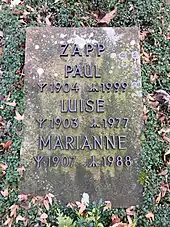ᛦ
 | ||||||||
| ||||||||
Translingual
Etymology
From Elder Futhark ᛉ. The rune was flipped upside down around the 400s-500s, as can be seen on the inscription of the Järsberg Runestone.
Coordinate terms
See also
Further reading
 Algiz § Younger Futhark on Wikipedia.Wikipedia
Algiz § Younger Futhark on Wikipedia.Wikipedia
German

The "life rune" and "death rune" on a grave marker in Niederaula, Germany.

The runes on a grave in Hamburg.
Etymology
From the interpretation as Todesrune (“death rune”).
Usage notes
The rune is part of the Armanen runes,[1] which are based on the Younger Futhark. The visual representation of the rune in the original publication is closer to ⟨ᛣ⟩, with straight arms to mirror ⟨ᛉ⟩, but this denotes a different letter, Old English calc /k/, and not yr. There is currently no specific codepoint in Unicode for straight-armed yr as opposed to curved-armed yr, so both are conventionally encoded as ⟨ᛦ⟩.
References
- Guido von List (1908) Das Geheimnis der Runen, published 1938, page 19
This article is issued from Wiktionary. The text is licensed under Creative Commons - Attribution - Sharealike. Additional terms may apply for the media files.